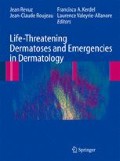-
Frostbite of the extremities affects two distinct groups of people: an ‘at-risk’ urban population, mainly the homeless, and persons exposing themselves to an arctic environment, i.e., climbers, polar explorers, etc.
-
A localized cold-induced lesion, or frostbite, is defined as tissue injury resulting from the prolonged exposure of flesh to a temperature of less than 0°C.
-
Improvement in the quality of textiles and clothing protections diminishes the impact of frostbite, yet it can still develop because of an insidious and painless onset.
-
Frostbite injury most often involves the hands and feet, and less often the ears, nose and cheeks.
-
Frostbite can result in catastrophic amputations, sometimes quite proximally on the affected limbs of previously healthy young men.
-
A new classification of frostbite, based on initial clinical examination, has the advantage of establishing a long-term prognosis early on in the management of frostbite.
-
Thrombolytic agents and prostacyclin used in the early phase of treatment of frostbite offer new hope to reduce the risk of amputation and sequelae from frostbite injury.
Access this chapter
Tax calculation will be finalised at checkout
Purchases are for personal use only
Preview
Unable to display preview. Download preview PDF.
References
Knize DM, Weatherley-White RC, Paton BC, Owens JC. Prognostics factors in the management of frostbite. J Trauma. 1969; 9: 749.
Heggers JP, Robson MC, Manavalen K et al. Experimental and clinical observations on frostbite. Ann Emerg Med. 1987; 16: 1056–62.
Groechenig E. Treatment of frostbite with iloprost (letter). Lancet. 1994; 344(8930): 1152–3.
Skolnick AA. Early data suggest clot-dissolving drug may help save frostbitten limb amputation (news). JAMA. 1992; 267: 2008–10.
Zdeblick TA, Field GA, Shaffer JW. Treatment of experimental frostbite with urokinase. J Hand Surg [Am]. 1988; 13(6): 948–53.
Voinov AI. Clinical classification of cold injury and prognostication of the depth of tissue damage during the acute period. Klin Khir. 1989; 12: 41–43.
Chernetsov AA. The classification and treatment of frostbite. Voen Med Zh. 1992; 10: 26–28.
Botta-Kauer Y. Les brûlures de la main. Med et Hyg. 1997; 55: 2369–72.
Mills WJ Jr. Clinical aspects of frostbite injury. In: Proceeding of the Symposium on Artic Medicine and Biology. IV. Frostbite, Fort Wainwright, Alaska: Artic Aeromedical Laboratory, 1964.
Mills WJ. Summary of treatment of the cold injured patient: frostbite. Alaska Med. 1993; 35: 61–6.
Cauchy E, Chetaille E, Lefevre M, Kerelou E, Marsigny B. The role of bone scanning in severe frostbite of the extremities. A retrospective study of 88 cases. Eur J Nucl Med. 2000; 48: 497–502.
Cauchy E, Chetaille E, Marchand V, Marsigny B. Retrospective study of 70 cases of severe frostbite lesions: a proposed new classification sheme. Wilderness Environ Med. 2001; 12(4): 248–55.
Bruen KJ, Ballard JR, Morris SE et al. Reduction of the incidence of amputation in frostbite injury with thrombolytic therapy. Arch Surg. 2007; 142: 546–553.
Valnicek SM, Chasmar LR, Clapson JB. Frostbite in the prairies: a 12-year review. Plast Reconstr Surg. 1993; 92: 633–41.
Reamy B V. Frostbite: review and current concepts. J Am Board Fam Prac. 1998; 11(1): 34–40.
Pollard AJ, Murdoch DR. The high altitude medicine handbook. Abingdon: Radcliffe Medical Press, 2003.
Killian H. Terminology and division into groups of localised cold injuries. In: Cold and Frost Injuries. Berlin: Springer-Verlag, 1981; pp 25–37.
Washburn B. Frostbite. N Eng J Med. 1962; 266: 974–89.
Boswick JA Jr., Thompson TD, Jonas RA. The epidemiology of cold injuries. Surg Gynecol Obstet. 1979; 149: 326–32.
Mills WJ. Summary of treatment of the cold injured patient: frostbite. Alaska Med. 1993; 35: 61–66.
Merymann HT. Freezing injury and its prevention in living cells. Annu Rev Biophys Bioeng 1974; 3: 341–63.
Manson PN, Jesudass R, Marzella L, Bulkley GB, Im MJ, Narayan KK. Evidence for an early free radical-mediated reper-fusion injury in frostbite. Free Radic Biol Med 1991; 10: 7–11.
Robson MC, Heggers JP. Evaluation of frostbite blister fluid as a clue to pathogenesis. J Hand Surg [Am]. 1981; 6: 43–47.
Raine TJ et al. Antiprostaglandins and antithromboxanes in the treatment of frostbite. Surg Forum. 1980; 31: 557–8.
McCauley RL, Smith DJ, Robson MC, Heggers JP. Frostbite. In Wilderness Medicine by Auerbach PS (ed.). St Louis: Mosby, 2001 (4th ed).
Barker JR, Haws MJ, Brown RE, Kucan JO, Moore WD. Magnetic resonance imaging of severe frostbite injuries. Ann Plast Surg 1997; 38: 275–9.
MartínezVillén G, Morandeira JR. Patología localizada por acción del frío: “congelaciones”. In: Morandereira JR, Martínez Villén G, Masgrau L, Avellanas M, editors. Manual Básico de medicina de montaña. Zaragova: Prames, 1996. pp. 171–4
Taylor MS. Lumbar Epidural Sympathectomy for frostbite injuries of the feet. Mil Med. 1999; 164: 566–567.
Murphy JV, Banwell PE, Roberts AHN, McGrouther AD. Frostbite: pathogenesis and treatment. J Trauma. 2000; 48(1): 171–178.
Heimburg D, Noah ME, Siekmann UPF, Pallua N. Hyperbaric oxygen treatment in deep frost bite of both hands in a boy. Burns. 2001; 27: 404–408.
Finderle Z, Cankar K. Delayed treatment of frostbite injury with hyperbaric oxygen therapy: a case report. Av Spc Env Med. 2002; 73(4): 393–394.
Author information
Authors and Affiliations
Editor information
Editors and Affiliations
Rights and permissions
Copyright information
© 2009 Springer-Verlag Berlin Heidelberg
About this chapter
Cite this chapter
Cauchy, E., Carron, S., Verhellen, R., Bernard, F. (2009). Frostbite Injury Management in Emergency. In: Revuz, J., Roujeau, JC., Kerdel, F.A., Valeyrie-Allanore, L. (eds) Life-Threatening Dermatoses and Emergencies in Dermatology. Springer, Berlin, Heidelberg. https://doi.org/10.1007/978-3-540-79339-7_24
Download citation
DOI: https://doi.org/10.1007/978-3-540-79339-7_24
Publisher Name: Springer, Berlin, Heidelberg
Print ISBN: 978-3-540-79338-0
Online ISBN: 978-3-540-79339-7
eBook Packages: MedicineMedicine (R0)

